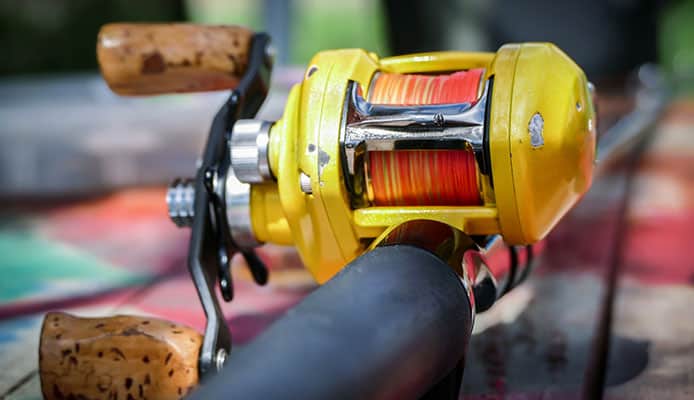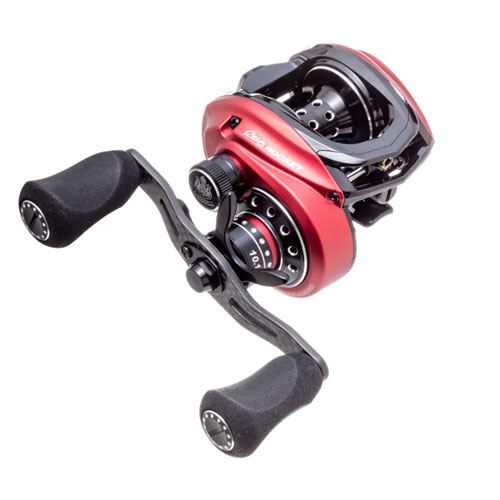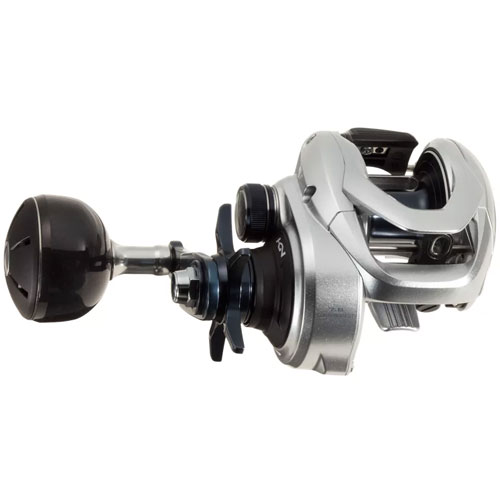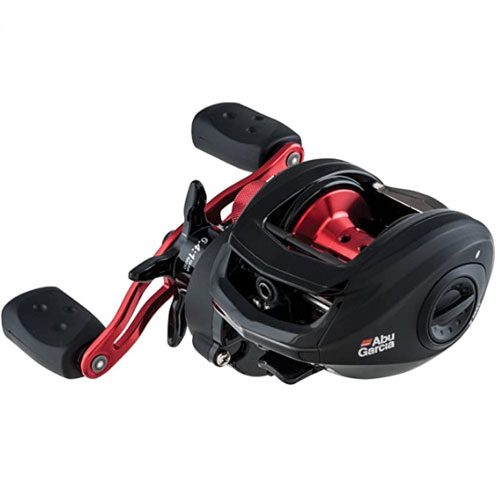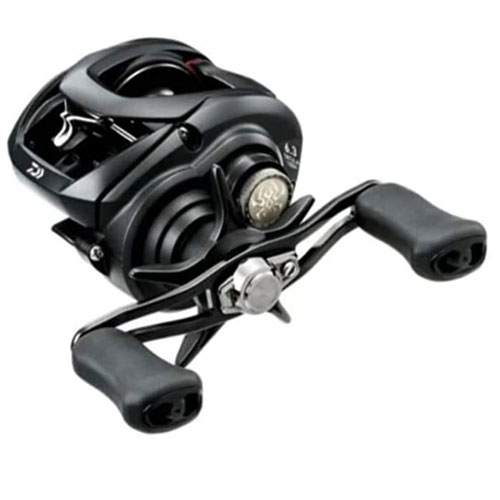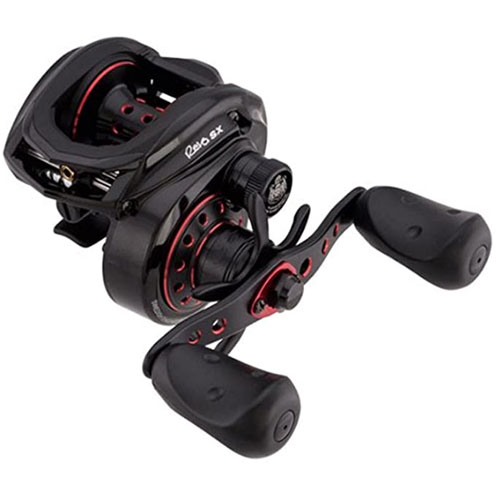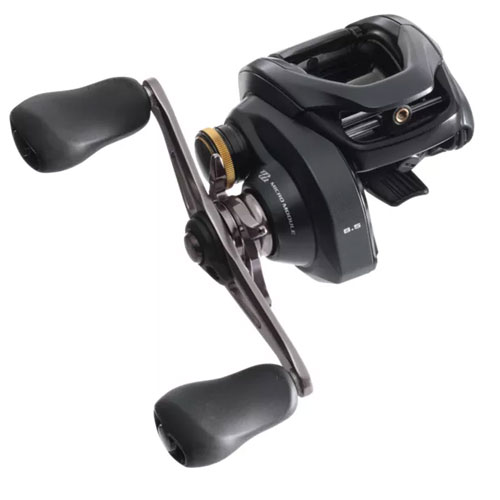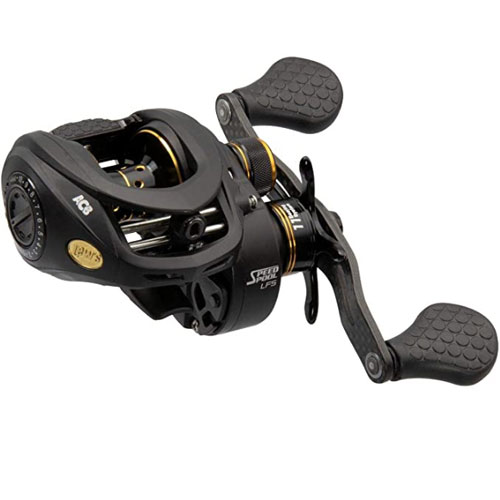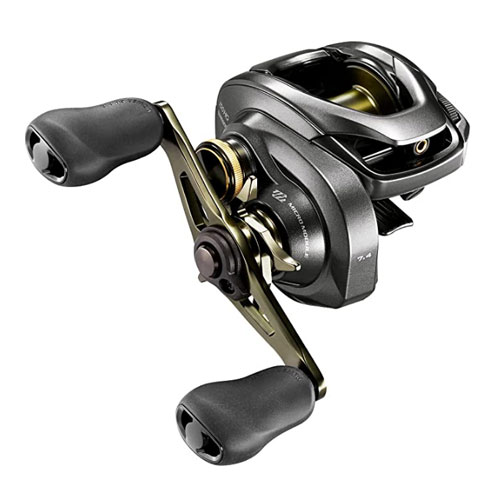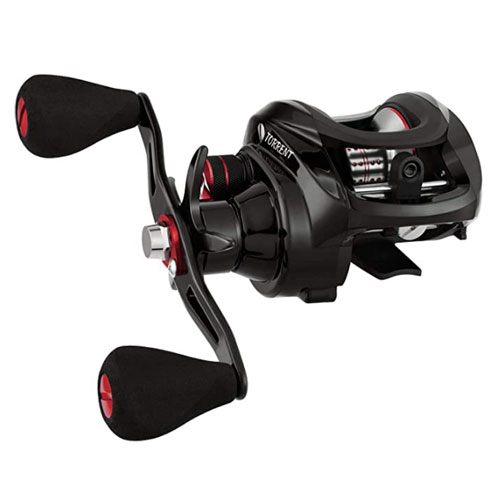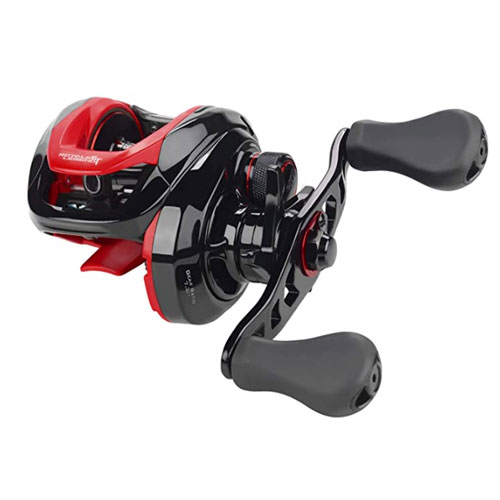-
1.
-
2.
-
3.
-
4.
-
5.
If you want to go after the big fish, you need one of the best baitcasting reels equipped for the hard fights you’ll be in for. If you’re just getting started in baitcasting and looking for your very first baitcaster, there is a learning curve and you will have to deal with some nasty backlashes that might make you question whether baitcasting is for you. But with patience and practice, you will soon be able to fine-tune the controls, thumb the spool like a pro, cast smoothly throwing lures far away and with pinpoint accuracy, and have a lot of fun.
Here we’ve reviewed the best baitcasting reels and outlined what to look for when shopping for a baitcasting reel based on several baitcasting reel reviews.
OUR TOP PICK
Abu Garcia Revo Rocket Baitcasting Reel
- What Makes This Baitcasting Reel Stand Out
- Combination of exceptional speed, power, and strength
- Power Stack Carbon Matrix Drag System offers good power and stability
- Gull Wing side plates promote easy brake access
- The Lube port allows for easy maintenance
- EVA knobs fitted on the bent handle for superior grip
- High efficiency D2 gear system
Weight: 7.3 oz.
Retrieve: Left/right
Gear ratio: 10.1:1
Ball bearings: 10+1
Line capacity: 12/145
Braid capacity: 20/190
Max drag: 18 lbs.
EDITORS CHOICE
Shimano TranX 300/400 Baitcasting Reel
- What Makes This Baitcasting Reel Stand Out
- Built for big bait and big fish
- Compact and ergonomic profile to easily fit into fishing bags
- Durable precision aluminum S3D spool for better accuracy
- Coreprotect system seals water out for casting efficiency
- double handles with oversized rubber paddles
- Choose between a power handle and a double power handle
Retrieve: Left/right
Gear ratio: 5.8:1/7.6:1
Ball bearings: 5+1
Line capacity: 14/180, 14/260
Braid capacity: 50/190, 65/170
Max drag: 18 lbs. – 22 oz.
BEST VALUE
Abu Garcia Black Max X Low Profile Baitcasting Reel
- What Makes This Baitcasting Reel Stand Out
- Duragear brass baitcaster gear built for amateurs and pros-alike
- Built with improved casting accuracy and increased range
- The magnetic brake system enhances casting with high deceleration rates, such as casting against winds
- Low profile and recessed reel design for ergonomic grip and comfortable feel-
- The Power Drag system offers smooth drag while pulling in hard fighting fish
- A great option for anglers on a budget
Weight: 7.4 oz.
Retrieve: Right
Gear ratio: 6.4:1
Ball bearings: 4+1
Line capacity: 17/85
Braid capacity: 10/150
Max drag: 15 lbs.
Daiwa Tatula 100 TWS Baitcasting Reel
- What Makes This Baitcasting Reel Stand Out
- Built for junior anglers with small hands
- Zero Adjuster factory setting for fine-tuned casting
- 90mm BC handle facilitates medium to heavy duty fishing
- The proprietary T-Wing system reduces line noise and backlash while promoting accurate longer casts
- MagForce –Z magnetic cast control for optimized casting distance
- Ultralight ad robust aluminum body resists corrosion and impact
Weight: 6.9 oz.
Retrieve: Left
Gear ratio: 6.3:1
Ball bearings: 7+1
Line capacity: 12/145
Braid capacity: 40/110
Max drag: 11 lbs.
Abu Garcia Revo SX Low Profile Baitcasting Reel
- What Makes This Baitcasting Reel Stand Out
- Best suited for a variety of lures, baits, and a selection of traditional casting techniques
- Powerful drag system with a drag capacity of up to 24 lbs.
- Dragger bass gear enhances the gear’s durability
- DuraClutch design tackles thumb bar resistance, especially with heavy baits
- Spool design allows the reel to handle extreme loads and improve castability
- The thick carbon washer extends drag durability
Weight: 7.83 oz.
Retrieve: Left/right
Gear ratio: 6.6:1
Ball bearings: 9+1
Line capacity: 10/175
Braid capacity: 20/190
Max drag: 24 lbs.
- What Makes This Baitcasting Reel Stand Out
- Ideal for freshwater and saltwater fishing
- High gear ratio to accommodate varying fishing conditions
- Longer and fuller strong handle design for easier casting and retrieval
- Optimized wide ranging SVS infinity brake system
- Shimano’s advanced MicroModule gearing for improved performance
- Shimano stable spool design for rotational smoothness
Weight: 7.6 – 7.8 oz.
Retrieve: Right/left
Gear ratio: 6.2:1/ 7.4:1/8.5:1
Ball bearings: 6+1
Line capacity: 10/155
Braid capacity: 50/120
Max drag: 11 lbs.
Lew’s Fishing Tournament Pro Baitcasting Reel
- What Makes This Baitcasting Reel Stand Out
- Built for professionals and amateurs alike
- The rugged carbon fiber system offers generous drag capacity
- Audible click anodized aluminum star drag
- Lightweight 95mm carbon fiber handle with combat style grip knobs
- Exclusive Lew’s patented Speed Keeper hook keeper
- Effective double anodized aluminum spool tension adjustment with Speed Dial line indicator
Weight: 9.6 oz.
Retrieve: Left
Gear ratio: 6.8:1
Ball bearings: 10+1
Line capacity: 12/120
Braid capacity: 50/120
Max drag: 20 lbs.
Shimano CURADO DC LowProfile Baitcasting Reel
- What Makes This Baitcasting Reel Stand Out
- Computerized intelligent digital control braking system with 4 settings for automated adjustment
- Handles various lures and bait, including casting frogs
- Micro Module Gear System for increasingly efficient gear train with less gear feel
- X-Ship supports pinion gear on bearing ends to support heavy loads
- Aluminum Hagane body eliminates body flexing and optimizes strength
- Minimal backlash with optimal casting distance
Weight: 7.8 oz.
Retrieve: Right
Gear ratio: 6.2:1
Ball bearings: 6+1
Line capacity: 10/120
Braid capacity: 30/135
Max drag: 11 lbs.
Piscifun Torrent Baitcasting Reel
- What Makes This Baitcasting Reel Stand Out
- Five strategically magnetic of the brake system optimize the magnetic effect on the spool
- Precision dial-in gauge controls backlash efficiently
- The simple lever releases the removable side plate for easy maintenance and cleaning
- Quick oil port design reduces the risks of losing parts
- Double line winding shafts for stability, performance, and strength
- varied gear ratio and low profile design accommodates versatile anglers
Weight: 8 oz.
Retrieve: Right
Gear ratio: 5.3:1
Ball bearings: 5+1
Line capacity: 10/120
Braid capacity: 10/195
Max drag: 18 lbs.
KastKing Royale Legend GT Baitcasting Reel
- What Makes This Baitcasting Reel Stand Out
- Ideal for competitive and recreational fishing
- Low profile, palm friendly reel design
- The quadruple disc carbon drag system promotes generous drag capabilities
- Eight strategically places crossfire magnets improve braking efficiency and casting control
- Stunning red and black matte exterior finishing
- Ideal for freshwater and saltwater fishing
Weight: 7.2 oz.
Retrieve: Left
Gear ratio: 7.2:1
Ball bearings: 5+1
Line capacity: 10/130
Braid capacity: 40/130
Max drag: 17.6 lbs.
How To Choose A Baitcasting Reel – Buying Guide
Shopping for a new baitcasting reel? If you have already found the perfect one among those we reviewed, then, you’re all set up to catch some trophy fish. If you’re still finding it hard to decide, here’s a guide to help you determine the best baitcasting reel.
Related Review: Baitcasting Reel Under 100
Gear Ratios
The gear ratio on a reel indicates how many times the spool revolves with each turn of the handle. A 7:1 gear ratio means that for every turn of the handle, the spool spins 7 times. Baitcasters are designed for more aggressive retrievals and usually have higher gear ratios. A higher gear ratio such as 7.3:1 or 8.3:1 offers a high-speed retrieval, as a lot of lines are picked up with every turn. Lower gear ratios such as 5.2:1 and 5.3:1 retrieve slowly but offer more cranking power and you may prefer them if you want more torque to haul bigger saltwater fish out of heavy cover. They are best suited to deep diving crankbaits, big swimbaits, and slow rolling heavy spinnerbaits.
Brake System
The braking system on a reel is an important feature to check if you want to avoid backlash after backlash. Magnetic braking systems are the simplest to use and the least expensive. They rely on magnets to control the speed throughout the entire cast, applying a constant resistance throughout. They are great for learning baitcasting but don’t allow for minute adjustments.
Pros prefer the centrifugal (friction) braking system that relies on centrifugal force and pins. Its advantage is that it offers the freedom to make specific adjustments where needed such as when casting into the wind. On the other side of the braking system is usually a spool tension knob that applies physical pressure on the spool at the beginning of the cast. You use it to adjust the spool speed according to the weight of the lure.
Line Capacity
A reel’s line capacity is usually indicated on the spool. The best low profile baitcasting reels have plenty of line capacity to handle the most common species such as trout and bass and suit the needs of most fishermen. If you will be going after large saltwater gamefish and species like salmon, muskies, and steelheads, you need a reel whose spool with a large line capacity, as you will need a lot of lines to be equipped to handle the long runs you’ll have to deal with.
Related Review: Trout Spinning Reel
Right Handed vs Left-Handed Baitcasting Reels
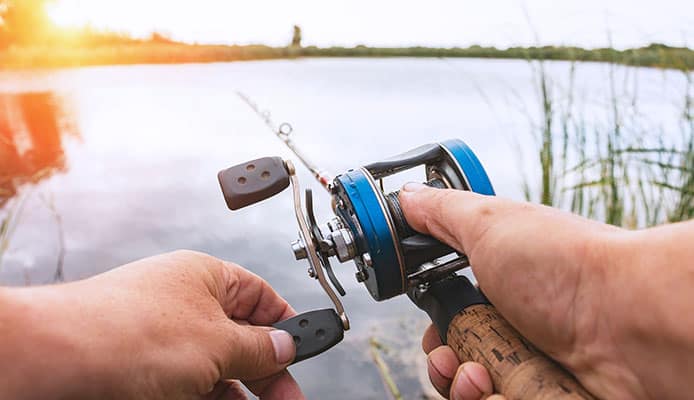
If this is your first baitcaster or you’re used to spinning reels, it is a good idea to choose a reel with the handling opposite to that of your dominant hand. This will ensure a more efficient workflow as you won’t have to switch hands after casting to start reeling.
Bearings
A reel with fewer but high-quality bearings performs better and lasts longer than a reel with plenty of poor quality bearings. Most reels have stainless steel bearings while some high-end reels feature ceramic bearings. Both are durable and rust-resistant. You also want to ensure the bearings are sealed, shielded, or double-shielded to prevent abrasion and corrosion, especially if you’ll be using your reel anywhere near saltwater. An instant anti-reverse system is also a great feature. This is a special type of bearing that ensures the handle only turns forwards and not backward.
Frame
A one-piece frame is best. The frame is the reel’s foundation and construction from a single block of material that gives it rigidity and stability. Aluminum or magnesium frames are strong and durable. Graphite or carbon fiber is lightweight and comfortable to use but not as resistant to flexing as aluminum is. For lighter applications, graphite is a good option. For larger saltwater game fish, a die-cast or machined aluminum frame has the required strength. There are also composite frames made from a combination of graphite and aluminum. As long as these are pieced together well to create a strong body, they also function well.
Handle
A larger and longer handle offers more power to bring large fish out of heavy cover. A shorter handle gives you more control for lighter fishing applications.
Weight
A lightweight reel that weighs under 7 ounces is comfortable to handle and you can use it all day without discomfort. If you’re casting and retrieving using a heavy reel, the arm and wrist fatigue you will experience will have you ending your excursion earlier than planned.
Spool
When targeting big fish or using techniques like trolling, you need a bigger/deeper spool that can handle the thicker, heavier, and longer fishing line you need. You may want to go with a round profile reel for its higher line capacity. Smaller/shallow spools are easier to cast and produce fewer line issues when casting thin diameter lines short distances and when you don’t need too much line. However, they’re inadequate for long casts with large diameter lines.
Drag System
The drag system on a baitcasting reel is designed to apply enough resistance to prevent a fast-swimming fish from pulling all the line off of your reel or snapping your line or rod and also to tire it out. Most baitcasting reels feature carbon fiber drag systems. It is also important that the drag system is easy to adjust and offers you a full range of adjustments enabling you to fine-tune the drag to exactly the level you need to land a fish efficiently.
FAQs
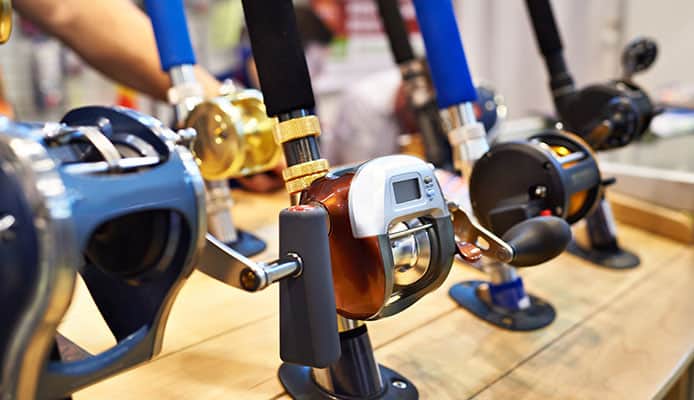
Q: Why Use a Baitcasting Reel?
The best baitcasting reel will be sturdy and equipped with powerful features such as higher gear ratios, more quality bearings, and powerful drag pressures for smooth performance when bringing in large fish. By using a baitcasting reel, you’re able to enjoy the following advantages:
Related Review: Spinning Reel Under 50
- More Control and Accuracy: When using a baitcaster reel, you can control the speed of the line when casting by using the brakes and by thumping the spool. This gives you the ability to drop your bait or lure exactly where you want it in a challenging environment.
- Longer Casting Distance: The way the fishing line comes off directly through the line guide and straight through the rod guides enables baitcasting reels to achieve superior casting distance. As long as you have the best baitcasting reels and have paired it with a great baitcasting rod, you will be able to launch your baits very far away.
- More Power: The design of a baitcaster and the layout of its spool enables it to cast heavier pound test lines and lures efficiently and gives a baitcaster more power to bring in stronger fish and fish heavy covers. Baitcasters with a low gear ratio also offer more cranking power for hauling large fish, making them suitable for power fishing applications such as pitching and flipping.
Q: How To Use A Baitcasting Reel?
Baitcasting reels have a free-spinning spool that makes them susceptible to line tangling. Here’s how to use a baitcaster properly and avoid the much-dreaded bird’s nests:
Prepare Your Baitcasting Outfit: Attach your baitcasting reel to a compatible baitcasting rod. Add an appropriate fishing line whose size is within the capacity indicated on the spool and string the line through the guides. Tie a lure or a suitable casting weight at the end of your line. You can start with a 0.5oz weight.
Adjust the Brakes for Your Lure Weight: Before you start casting, set the reel properly to match the weight of the lure. You do this by turning the tension knob on the side of the reel under the drag on the handle. Turning this knob will tighten or loosen the brake tension.
To set your brake for the 1/2oz weight, raise your rod tip in front of you until the weight is hanging seven or eight feet above the ground. Depress the thumb bar on your reel to activate the free spool mode. Watch the line on the spool as the casting weight hits the ground.
If the spool continues to spin after this, you will need to tighten the brake a bit. If the weight doesn’t drop to the ground, the brake is too tight and needs loosening. Adjust the braking system accordingly and repeat the process, fine-tuning the brake until the spool stops moving when the weight drops to the ground.
Cast with Your Baitcasting Reel: With the brake properly set for the current lure weight, you’re now ready to cast using your baitcaster:
- Put your baitcast reel in free spool mode by depressing the thumb bar then quickly apply your thumb on the spool to stop the spool from rotating before you begin the cast
- Just like with any overhead cast, raise the rod tip back over your shoulder
- Swing the rod forward under moderate power and stop your rod tip at the eleven o’clock position then release your thumb from the spool
- Even as you release your thumb from the spool, maintain the lightest pressure on the line on top of the spool as the line continues to spin-off to prevent the spool from spinning too fast. This is what is referred to as feathering the line
- Ideally, the weight or lure should land on the ground in front of you and the fishing line on the spool should be tangle-free
Vary the Weights and Distance: Keep casting the same weight until you can consistently achieve a decent distance without experiencing line tangles. You can then practice with different weights remembering to reset the brake tension with every new weight you tie to the line. You will find that casting heavier weights using your baitcasting reel is easier than casting lighter weights.
Once you can smoothly cast the weights short distance, you can then work at increasing your casting distance by applying more power to your cast.
To do this, loosen the brake a little and go through the above casting motions. Most likely, you’ll gain some distance but experience some tangles. Repeat the cast while applying a little more thumb pressure and try to stop the line with your thumb as you feel the casting weight or lure hit the ground.
Globo Surf Overview
Baitcasting reels are the right equipment for casting heavier lures and lines and going after large fish. Once you find the right baitcaster, ensure that you match it up with a compatible baitcasting rod so you have a well-balanced baitcaster combo that will perform flawlessly. Once you get the best baitcasting reel for your needs, you will be ready to go after the big fish and experience the benefits of using this powerful type of fishing reel.
More Fishing Reviews:
- Fishing Shorts
- Trolling Rods
- Topwater Lures
- Baitcasting Rod
- Kids Fishing Poles
- Hooks For Catfish
- Fly Fishing Waders
- Crappie Bait
- Crab Traps
- Tackle Box
More Reel Reviews:
Have you used any of the baitcasting reels we’ve reviewed above? What was your experience fishing with it? Share with us in the comment box below



